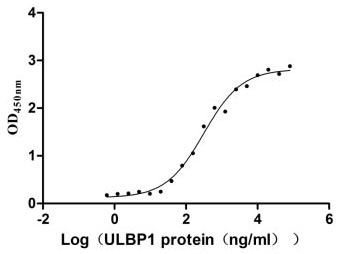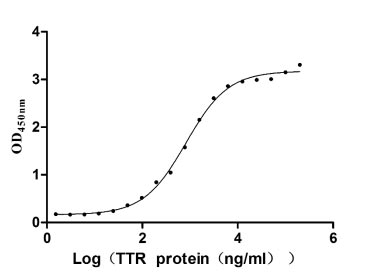Recombinant Mouse Tumor necrosis factor receptor superfamily member 11A (Tnfrsf11a), partial
-
货号:CSB-YP023968MO1
-
规格:
-
来源:Yeast
-
其他:
-
货号:CSB-EP023968MO1
-
规格:
-
来源:E.coli
-
其他:
-
货号:CSB-EP023968MO1-B
-
规格:
-
来源:E.coli
-
共轭:Avi-tag Biotinylated
E. coli biotin ligase (BirA) is highly specific in covalently attaching biotin to the 15 amino acid AviTag peptide. This recombinant protein was biotinylated in vivo by AviTag-BirA technology, which method is BriA catalyzes amide linkage between the biotin and the specific lysine of the AviTag.
-
其他:
-
货号:CSB-BP023968MO1
-
规格:
-
来源:Baculovirus
-
其他:
-
货号:CSB-MP023968MO1
-
规格:
-
来源:Mammalian cell
-
其他:
产品详情
-
纯度:>85% (SDS-PAGE)
-
基因名:
-
Uniprot No.:
-
别名:Tnfrsf11a; Rank; Tumor necrosis factor receptor superfamily member 11A; Osteoclast differentiation factor receptor; ODFR; Receptor activator of NF-KB; CD antigen CD265
-
种属:Mus musculus (Mouse)
-
蛋白长度:Partial
-
蛋白标签:Tag type will be determined during the manufacturing process.
The tag type will be determined during production process. If you have specified tag type, please tell us and we will develop the specified tag preferentially. -
产品提供形式:Lyophilized powder
Note: We will preferentially ship the format that we have in stock, however, if you have any special requirement for the format, please remark your requirement when placing the order, we will prepare according to your demand. -
复溶:We recommend that this vial be briefly centrifuged prior to opening to bring the contents to the bottom. Please reconstitute protein in deionized sterile water to a concentration of 0.1-1.0 mg/mL.We recommend to add 5-50% of glycerol (final concentration) and aliquot for long-term storage at -20℃/-80℃. Our default final concentration of glycerol is 50%. Customers could use it as reference.
-
储存条件:Store at -20°C/-80°C upon receipt, aliquoting is necessary for mutiple use. Avoid repeated freeze-thaw cycles.
-
保质期:The shelf life is related to many factors, storage state, buffer ingredients, storage temperature and the stability of the protein itself.
Generally, the shelf life of liquid form is 6 months at -20°C/-80°C. The shelf life of lyophilized form is 12 months at -20°C/-80°C. -
货期:Delivery time may differ from different purchasing way or location, please kindly consult your local distributors for specific delivery time.Note: All of our proteins are default shipped with normal blue ice packs, if you request to ship with dry ice, please communicate with us in advance and extra fees will be charged.
-
注意事项:Repeated freezing and thawing is not recommended. Store working aliquots at 4°C for up to one week.
-
Datasheet :Please contact us to get it.
相关产品
靶点详情
-
功能:Receptor for TNFSF11/RANKL/TRANCE/OPGL; essential for RANKL-mediated osteoclastogenesis. Involved in the regulation of interactions between T-cells and dendritic cells.
-
基因功能参考文献:
- lactation increases physiological maxillary bone remodeling and orthodontic tooth movement, and both require activation of RANK/RANKL/OPG system PMID: 29382610
- RANK deficiency ameliorates podocyte injury by suppressing calcium/calcineurin/NFATc1 signaling PMID: 30036881
- TNFalpha and RANKL promote osteoclastogenesis by upregulating RANK via the NFkappaB pathway. PMID: 29512766
- Results from this study demonstrate that RANK signalling in NPY neurons is involved in modulating NPY levels and through that matching bone mass to body weight. PMID: 29477253
- the investigation of RANK and RANKL as possible novel immunotherapy targets in cancer is a rational approach. Here we have defined the mechanism of action of RANKL-RANK blockade in combination with anti-CTLA4, and provide insight into the combination efficacy observed in the case reports. PMID: 28634284
- Insulin induces RANK expression via ERK1/2, which contributes to the enhancement of osteoclast differentiation. PMID: 28535663
- This indicated that RANK might be the binding target of baicalin. In sum, our findings revealed baicalin increased osteoclast maturation and function via p-ERK/Mitf signalling. In addition, the results suggest that baicalin can potentially be used as a natural product for the treatment of bone fracture PMID: 28158928
- RANKL/RANK control progenitor cell expansion and tumorigenesis in inherited breast cancer. PMID: 27241552
- RANK rewires energy homeostasis in murine lung cancer cells and promotes expansion of lung cancer stem-like cells PMID: 29118048
- Artesunate inhibits RANKL-induced osteoclastogenesis by suppressing the NF-kappaB signaling pathway. PMID: 28294321
- Data suggest that mutations at position I248 in DE-loop of murine RANKL have effects on interaction of RANKL with RANK and on subsequent activation of osteoclastogenesis by this hetero-multimer. (RANKL = osteoclast differentiation factor; RANK = tumor necrosis factor receptor superfamily, member 11a protein) PMID: 28627025
- The persistence of bone erosion and synovial osteoclasts in Rank-deficient mice, and the ability of TNF/IL-6 to induce osteoclastogenesis, suggest that more than one cytokine pathway exists to generate these bone-resorbing cells in inflamed joints. PMID: 27563728
- Muscle RANK deletion had no significant effects on the sham or denervated slow-twitch soleus muscles. These data identify a novel role for RANK as a key regulator of Ca(2+)storage and SERCA activity, ultimately affecting denervated skeletal muscle function. PMID: 26825123
- present study shows that ginsenoside Rg3 protects against LPS-induced acute lung injury through inactivating the NF-kappaB signaling PMID: 26921732
- In palmatine-treated mice, RANKL and OPG expression decreased. In the culture supernatant of MC3T3-E1 cells, RANKL and OPG levels were significantly reduced by palmatine addition. PMID: 26546523
- Results show that moderate increases in affinity for RANK lead to a substantial augmentation of osteoclast formation, signaling, and bone resorption suggesting a biphasic relationship between RANKL/RANK affinity and osteoclastogenic capacity. PMID: 25864714
- We also show that R-spondin1 is depleted in RANK-null progenitors, and that its exogenous administration rescues key aspects of RANK deficiency by reinstating a WNT response and mammary cell expansion PMID: 26095608
- findings have uncovered a tumorigenic role for RANKL/RANK in the salivary gland and suggest that targeting this pathway may represent a novel therapeutic intervention approach in the prevention and/or treatment of this understudied head and neck cancer PMID: 26061636
- results indicate that the RANK IVVY motif cooperates with the TRAF-binding motifs to promote osteoclastogenesis, which provides novel insights into the molecular mechanism of RANK signaling in osteoclastogenesis. PMID: 26276390
- findings suggest CCN2 as a candidate of the fourth factor in the RANK/RANKL/OPG system for osteoclastogenesis, which regulates OPG and RANK via direct interaction PMID: 25554597
- Recapitulating the W434X mutation by transcription activator-like effector nuclease-mediated targeted disruption of Tnfrsf11a within the region homologous to W434X in the macrophage-like cell line RAW264.7 impaired formation of osteoclast-like cells. PMID: 24859969
- findings show that RANK siRNA delivered locally by a synthetic vector may be an effective approach for reducing osteolysis and may even stimulate bone formation in aseptic loosening of prosthetic implants. PMID: 25462844
- silencing angiopoietin-like protein 4 protects against LPS-induced acute lung injury via regulating SIRT1/NF-kB signaling pathway PMID: 25727991
- silencing of miR-503 using a specific antagomir in ovariectomy (OVX) mice increased RANK protein expression, promoted bone resorption PMID: 23821519
- The OPG/RANKL/RANK axis plays critical roles in controlling inflammation in ischemic brains. PMID: 24847069
- RANK signaling interferes with mammary cell commitment, contributing to breast carcinogenesis. PMID: 23766243
- Enteropeptidase could inhibit osteoclastogenesis in vitro through the cleavage of RANK. PMID: 23954298
- USP18 inhibits NF-kappaB and NFAT activation during Th17 differentiation by deubiquitinating the TAK1-TAB1 complex. PMID: 23825189
- Data show that cystatin C inhibits osteoclast differentiation and formation by interfering intracellularly with signaling pathways downstream RANK. PMID: 23572233
- These results suggest that cell adhesion signaling regulates RANK expression in osteoclast precursors. PMID: 23139818
- RANK signaling functionally contributes to key tumorigenic properties through a cell-autonomous homotypic mechanism PMID: 22421365
- Recombinant fusion construct RANK-Fc has the potential to prevent coxsackievirus B3-induced ectopic calcification and bone loss in this mouse model. PMID: 23303667
- Retrovirus-mediated shRNA targeting RANK inhibits osteoclast differentiation and osteolysis. PMID: 22913338
- the increase in RANK-RANKL expression is a response to podocyte injury, and RANK-RANKL may be a novel receptor-ligand complex for the survival response during podocyte injury. PMID: 22848465
- Fos plays an essential role in the upregulation of RANK expression in osteoclast precursors within the bone. PMID: 22454522
- CaMKII-RANK signaling interaction in the regulation of early osteoclastogenesis. PMID: 22428553
- Data indicate that the RANK IVVY motif, plays a crucial role in IL-1-mediated osteoclastogenesis. PMID: 22416138
- ablation of the RANKL-RANK pathway has no direct adverse effect on B cell physiology PMID: 22219325
- demonstrated a Rank-mediated reciprocal link between dendritic epidermal T cell progenitors and Aire(+) medullary thymic epithelial cell maturation PMID: 22425250
- that estrogens deficit is a strong stimulus for RANKLRANK/ OPG pathway that breaks an inhibitory influence of hypothyroidism even in IL-6 deficient mice. PMID: 21478097
- RANK signaling induces interferon -stimulated gene expression in both type I interferon-independent and interferon-dependent mechanisms. PMID: 21527253
- PPARgamma agonist inhibited the differentiation of RAW264.7 cells into osteoclasts by suppressing RANK. PMID: 21029677
- vRANK is a novel osteoclast suppressor that reduces the number of RANKL-induced mature osteoclasts mainly by negating the anti-apoptotic effect of RANKL. PMID: 21153864
- Estrogens modulate RANKL-RANK/osteoprotegerin mediated interleukin-6 effect on thyrotoxicosis-related bone turnover. PMID: 21332025
- the LTbetaR signal exhibits a novel and unique function in promoting RANK activity for medullary thymic epithelial cell organization PMID: 21441458
- Data suggest that RANK-RANKL regulates hair renewal and epidermal homeostasis and provides a link between these two activities. PMID: 21402940
- Sbds is required for osteoclastogenesis by regulating monocyte migration via Rac2 and osteoclast differentiation signaling downstream of RANK. PMID: 21084708
- RANKL and RANK are involved in mammary/breast cancer metastasis PMID: 21326202
- These results indicate that IL-1 directly activates RANK signaling other than inducing RANKL to promote osteoclastogenesis and plays an important role in physiological bone metabolism. PMID: 20679512
- IL-3 irreversibly inhibits RANK expression that results in inhibition of important signaling molecules induced by RANKL during osteoclastogenesis. PMID: 20691668
收起更多
-
亚细胞定位:Cell membrane; Single-pass type I membrane protein.
-
组织特异性:Ubiquitous expression with high levels in trabecular bone, thymus, small intestine, lung, brain and kidney. Weakly expressed in spleen and bone marrow.
-
数据库链接:
KEGG: mmu:21934
STRING: 10090.ENSMUSP00000027559
UniGene: Mm.6251




















